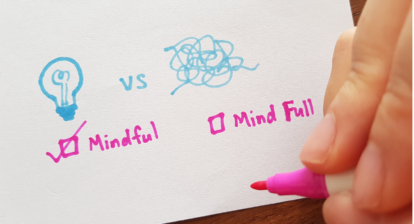Mindfulness at Work
After working for over twenty-five years for different companies, I have concluded that mindfulness has a place in the workplace. Workplaces are complex, fast-paced environments, which have become even more complex with hybrid working.
In those moments when we are rushed with back-to-back meetings and competing deadlines, the idea of pausing is foreign to most of us. However, a simple pause to create space and connect us to the moment has a powerful restorative impact. Mindfulness pulls us from the torrent of life that often disconnects us from ourselves, grounding us and providing us with a wider perspective and an understanding that provides clarity.
Mindfulness is simply non-judgemental awareness. Mindfulness makes us curious about what is unfolding rather than ploughing mindlessly through life. We pause to create space and clarity, to make more creative and wiser choices. Integral to mindfulness is kindness to oneself, something that, in the past, was not natural to me. Learning to gently acknowledge our faults rather than unleashing the fury of our inner critic, allows us to grow. It sounds a little fluffy, but the science demonstrates that self-compassion contributes to personal growth.
Where does mindfulness fit in a fast-paced, market-driven business environment? Research is growing on workplace mindfulness interventions, and early indications demonstrate that, when implemented appropriately, mindfulness benefits businesses. Organisations like Microsoft and SAP, which traditionally were process-driven, now see mindfulness as integral to building cultures that support personal growth and innovation. The benefits of incorporating mindfulness tools include:
- Building resilience
- Deepening connections
- Enhancing clear decision-making
However, one size does not fit all, and it is wise to consider a range of factors that will influence the success of mindfulness-based interventions in your organisation.
The Origins of Mindfulness
Understanding the lineage of mindfulness is important. Mindfulness originates from spiritual traditions and is woven into many religions. Only in recent years has science caught up with these ancient traditions that, for centuries, have promoted the virtues of living a mindful and compassionate life. It is vital to be explicit that workplace mindfulness tools do not propagate any religious views. However, acknowledging the origins of mindfulness promotes transparency. There are many schools of thought on mindfulness, and clarity on the science behind mindfulness is important to instil trust in any workplace mindfulness program.
Does Mindfulness Fit with your Culture?
A key element to consider when implementing workplace mindfulness training is how mindfulness aligns with your organisation’s culture. What is your business culture? Does your organisation’s culture sit comfortably with the key principles that underpin mindfulness practices?
John Kabat Zinn’s Mindfulness-Based Stress Reduction (MBSR) programme, which is internationally recognised and has been scientifically critiqued, is the gold standard in secular mindfulness training. The programme is underpinned by a framework the following attitudes:
- Non-judgment
- Patience
- Kindness
- Acceptance
- Beginners’ minds
- Letting go
- Gratitude
- Non-striving
Before diving into mindfulness training, it is useful to check if these attributes sit comfortably with your organisation’s culture. The attitudes are not black and white; in practice, people experience different shades of each attitude in different moments. Reflecting on your organisation’s culture in the context of these attitudes will provide an indication if mindfulness is a good fit for your business.
Consistently applying the attitudes in daily life is challenging, so it reasonable to expect challenges in integrating the attributes into a business culture. However, doing so will provide a solid foundation from which to build a mindful approach to business processes in your organisation.
For example, diversity and inclusion policies are based on non-judging. How are diversity and inclusion policies lived in your organisation? Does your business address unconscious biases? It is natural for everyone to make judgments; we are conditioned to do so from birth. Through mindfulness, you begin to notice and pay attention to your biases, it helps create an understanding about the collective unconscious biases at play in your organisation. Mindfulness helps to expose such biases and allows you to acknowledge the different lenses through which individuals perceive the world. Thus, mindfulness promotes diversity and inclusivity in the workplace. As Gandhi demonstrated, collectively mindful behaviours are impactful and lead to change for the better.
The attitudes are also a useful barometer to assess the appetite for mindfulness in your business. Therefore, before taking a deep dive into mindfulness training, I urge you to explore how the attitudes collectively apply in your workplace.
Understanding Your Target Audience
Another key consideration is understanding your target audience. Mindfulness is a form of mental training that explores the mind–body connection. Science acknowledges that mental health and mental illness are not two distinct states; rather, they exist on a continuum. Most of us, move along this continuum line and many of us at some stage in our lives will experience mental ill-health.
There are many ways to deliver corporate mindfulness training, which include using APPs, webinars, and a teacher-led approach. What channel you use is dependent on a multitude of variables which I will discuss in a later blog, however, the key is to ensure it is delivered safely.
Mindfulness training can tap into deep emotions and thoughts, and if the student is not guided and supported correctly, it can cause harm. A key premise in delivering mindfulness-based intervention training is to do no harm. If choosing the traditional method, a teacher-led approach, it is essential that you recruit the right person, suitably qualified and with a good understanding of the business environment. Ensure your organisation has tools in place to support individuals, particularly in relation to mental health if an issue arises. Such tools include an employee assistance program, mental health first aiders, or actively promote external support services such as the HSE’s Your Mental Health Campaign. Providing mental health awareness training for team leads encourages openness and prompts discussion on mental health in the workplace. Such resources ensure a safe roll-out of mindfulness training encourages engagement on mental health, which is often a taboo subject, particularly in workplace settings.
Conclusion
Mindfulness is a great tool and when implemented correctly has far-reaching positive outcomes. However, it is important to plan and complete the groundwork prior to rolling out mindfulness at work initiatives. Before implementing mindfulness training, start planning, by first exploring whether mindfulness is compatible with your organisation’s values and culture, assessing suitable delivery models, and ensuring supports are in place. Such an approach ensure that your workplace mindfulness initiatives are sustainable and rewarding.
[wpforms id=”6″]







